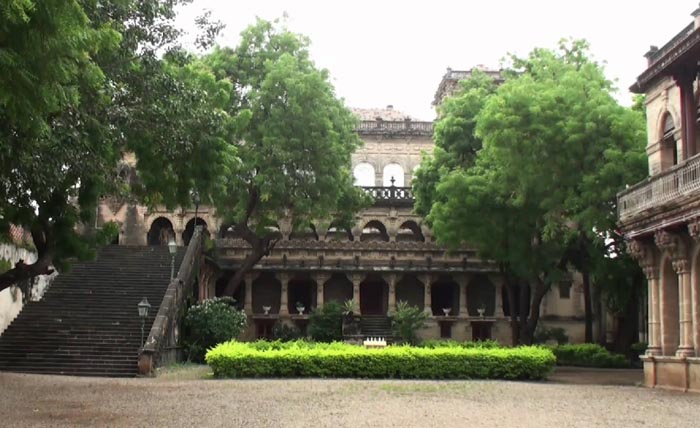Naulakha Palace

Information on Naulakha Palace (Rajkot, Gujarat) - History & Architecture
The Naulakha Palace is a particular monument that is located in the Gondal region in the Indian state of Gujarat. The place i.e. Gondal is well known for its significant tourism importance owing to the presence of a handful number of historical forts and monuments of the Indian history. The palace has a history of more than 300 years and it has been preserved quite well over the years.
Naulakha Palace Architecture
The palace has been constructed following the Mughal and Indian style of architecture. Some of the major architectural features of the palace include carved arches, magnificent lawns and courtyards along with spiral staircases among others. There is also a private museum within the palace which contains remnants relevant to the royal family of the Jadeja dynasty. The durbar hall is located at the central end of the palace and it is further graced by object and animal sculptures which are quite substantial to say the least. There is wooden furniture inside the palace which is believed to be made during the 17th century when the royal family of the Jadeja dynasty stayed in the palace. The entire palace is based on a grand stone that has an elevation of 30 metres above the water level. There is a grand tower clock which is located in front of the palace. The gates of the palace are quite big in size. The grand staircase of the palace leads directly to the artistically carved pavilions which is again one of the attractive architectural features of the palace.
Naulakha Palace History
Historically, the palace has been considered as one of among the noteworthy in Gujarat with the foundation stone of the structure being laid during the 17th century. Specifically mentioning, it can be said with reference to historical reports that the palace was built in the mid years of the 17th century. The city of Gondal was once served as the capital for the Jadeja Dynasty. The royal family of the dynasty not only built the palace but they also used the same as their residence for quite a long. The palace is located at the banks of the river Gondali which considerably enhance the scenic beauty of the palace. The design of the entire city in which the Navlakha Palace is positioned is credited to the work of the visionary ruler i.e. Sir Bhagwatsinhji. He personally supervised as well as designed the pattern of the town which can again be regarded as a 17th century masterpiece. Constructed and completed by the year 17th century, the palace is seen as one of the oldest buildings in the Gondal region of Gujarat. Over the years of its existence, the building has been able to remain intact under the supervision of the rulers who ruled over the structure and the state authorities in the present day context.
Naulakha Palace Tourism Importance
It is one of the most attractive palaces in Gondal and other parts of Gujarat. The city of Gondal is itself a visual treat for the people since it is planned township and each and every aspect has been established with systematic planning. Furthermore, the presence of a large number of forts and palace within the city further boost its tourism importance. This particular aspect will lead to the augmentation of the number of tourists in the city and in the palace as well. Moreover, since the city is easily accessible for the tourist both by roadways and railways, the number of tourists can increase significantly.
- Andaman Nicobar Monuments
- Andhra Pradesh Monuments
- Assam Monuments
- Bihar Monuments
- Chhattisgarh Monuments
- New Delhi Monuments
- Goa Monuments
- Gujarat Monuments
- Haryana Monuments
- Himachal Pradesh Monuments
- Jammu and Kashmir Monuments
- Karnataka Monuments
- Kerala Monuments
- Madhya Pradesh Monuments
- Maharashtra Monuments
- Odisha Monuments
- Punjab Monuments
- Rajasthan Monuments
- Tamil Nadu Monuments
- Telangana Monuments
- Uttar Pradesh Monuments
- West Bengal Monuments